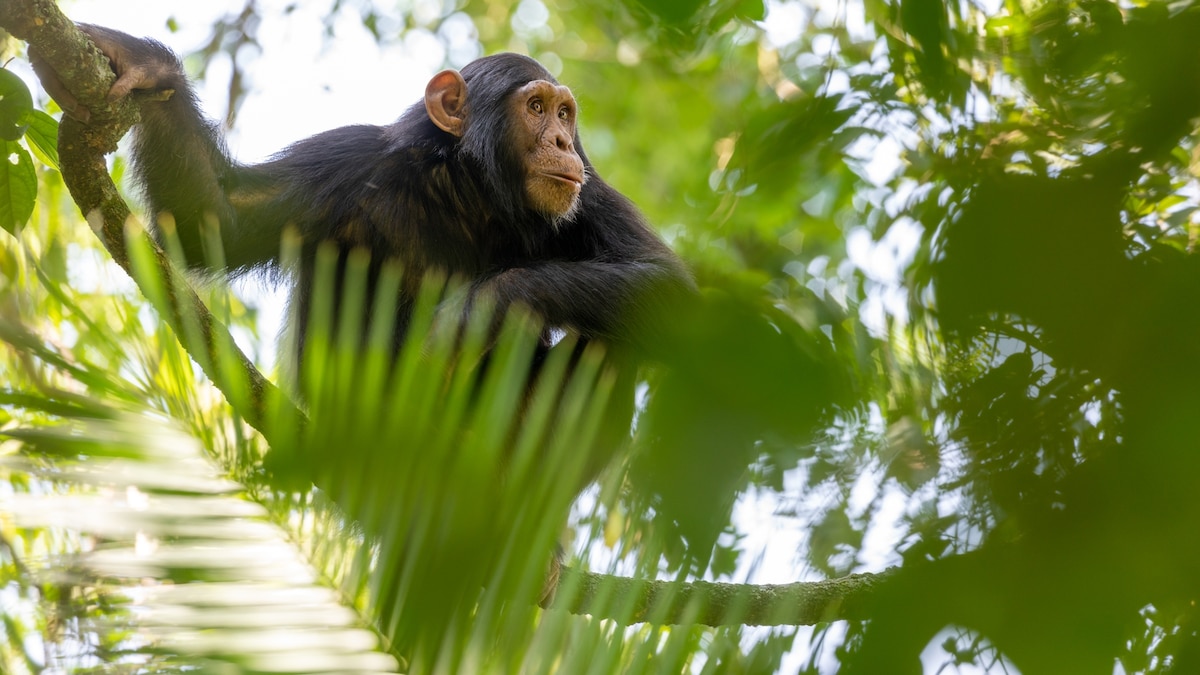Now Reading: Do chimpanzees have rhythm? Listen to their drumming.
-
01
Do chimpanzees have rhythm? Listen to their drumming.
Do chimpanzees have rhythm? Listen to their drumming.

“You feel it in your body when they drum—it’s insanely impressive,” says Vesta Eleuteri.
She’s a cognitive biologist at the University of Vienna who studies chimpanzee drumming and observed over 350 drumming performances like this in five African countries.
Chimpanzees in West Africa hold onto trees with their hands while kicking against roots with their feet, emitting powerful sounds that travel long distances, sometimes over a half mile.
“They’re so fast sometimes… their hands and feet are a blur,” says Catherine Hobaiter, primatologist at the University of St. Andrews, who was also involved with the research. “They will jump between the buttresses on these huge rainforest trees and almost dance around them, hitting them with their feet and hands. It’s really amazing to see.”
Eleuteri and Hobaiter’s findings that chimpanzees drum rhythmically on tree roots, and that different groups drum with different styles, was recently published in Current Biology. Their observations suggest drumming is a way to share information with other members of the group. It’s a unique mode of communication based on rhythmic percussion—a skill that humans and chimpanzees share. Scientists think it may have arisen in a common ancestor the two species share.
Another new study on some of the same chimpanzees, published in Science Advances, found they combine vocal sounds to convey complex meanings, a communication system which could be a stepping stone between animal communication and human language.
Together, these chimpanzee behaviors can help scientists understand how human music-making and language first developed.
“You’ve really got the building blocks of the kind of things we’ve used to make modern music, present long before humans were humans,” says Hobaiter.
Communicating with drumming and calls
Rhythmic music-making has long been considered uniquely human, and percussion is one of the earliest forms of human musical expression. Drumming can have different individual and regional styles but typically consists of non-random timing: hits are evenly spaced, aligning to a set rhythm.
Eleuteri and Hobaiter’s previous research discovered chimpanzees drum on buttress roots—large, wide roots growing above the soil—to send information over long and short distances. Each chimpanzee has their own unique drumming style, and they combine drumming with hooting to share where they are in the forest and what they’re doing.
Although all animals communicate, humans are considered the only species on Earth known to use language: combining sounds into words, and words into sentences, to create meaning.
Other animals like birds vocalize to send messages, and while some species do combine these calls, this behavior is typically limited to a few types of calls and to the context of alerting others to predators. Bonobos, which are closely related to chimpanzees and humans, also use complex combinations, primatologists think the mysterious origins of human language might come from a common ancestor shared by all three species 5 to 7 million years ago.
The new drumming study analyzed 371 drumming bouts in 11 chimpanzee communities in Côte d’Ivoire, Guinea, Senegal, Uganda, and Tanzania.
You May Also Like
“Until recently, there wasn’t a lot of convincing evidence for rhythmic behavior in primates that has any resemblance with human musical rhythm,” Pritty Patel-Grosz, a linguist at the University of Oslo who was not involved in the study but whose research explores rhythmic dancing in gibbons, wrote in an email. “[The] observation that chimpanzee drumming on tree buttresses exhibits properties of human musical behavior is another huge breakthrough.”
The same research project studying drumming chimps in Côte d’Ivoire also contributed to the new study on how chimps combine vocalizations. It analyzed over 4,000 recorded sounds from 53 chimpanzees.
Calls were connected to specific events: feeding, nesting, approaching, aggression, or predator encounters. Two-call vocalizations were combined to convey more meaning than a simpler call, spanning a range of day-to-day activities: for example, a “hoo” sound was usually used during feeding and travel, and a “pant” sound was mostly used during social activities with other chimpanzees, but a combined “hoo” and “pant” sound was used during nesting, creating a whole new meaning.
“We expected the system to be versatile, but that was beyond our expectations,” says study author Cédric Girard-Buttoz, evolutionary biologist at the French National Center for Scientific Research (CNRS). “The system has most of the linguistic phenomena we find in language.”
Complex chimpanzee vocalizations could represent an evolutionary bridge between more simplistic animal calls and open-ended human language, says Girard-Buttoz.
“Chimpanzee communication may incorporate the seeds of a human-like system,” Patel-Grosz writes of the findings.
Shared ancestors in rhythm and language
“In human cognition, many scholars have been arguing that language and music are closely related, and they may share the same cognitive resources,” wrote Patel-Grosz. For example studies showing the same parts of the brain process language and music.
Patel-Grosz proposes further research can better clarify this connection: “In other words, did chimpanzee vocal communication and chimpanzee rhythmic drumming evolve together, and can this inform our understanding of the evolution of language and music?”
“When investigating the evolution of human language, we usually compare it to the vocal communication of [animals],” says Maël Leroux, evolutionary biologist at University of Rennes, who was not involved in the new studies. “Human language is not vocal, it’s very much multimodal,” a combination of sounds and gestures.
That suggests the origins of human language are also multimodal, Leroux says.
Different drumming styles were observed in the different communities researchers studied, which may also reflect the variation in human language, says Leroux.
Western chimpanzees typically drummed more often and faster, while eastern chimpanzees drum more slowly and start drumming later in their hooting. Hobaiter thinks these differences are shaped by the different social structures seen between the eastern and western groups—eastern chimpanzees are more aggressive and hierarchical, and western chimpanzees are more cohesive and egalitarian—and Hobaiter points out that since rhythm is central to human sociality, dance, and speech, our social behaviors may have been tied to how we developed rhythm too.
“This is the kind of science that wakes us up to the fact that every single population of chimpanzees is worth conserving and preserving,” says Hobaiter. “We’re starting to recognize that they might have cultures in their communication, in their rhythm, in their social behavior… if you lose a group, you lose the unique culture that goes with it.”
























